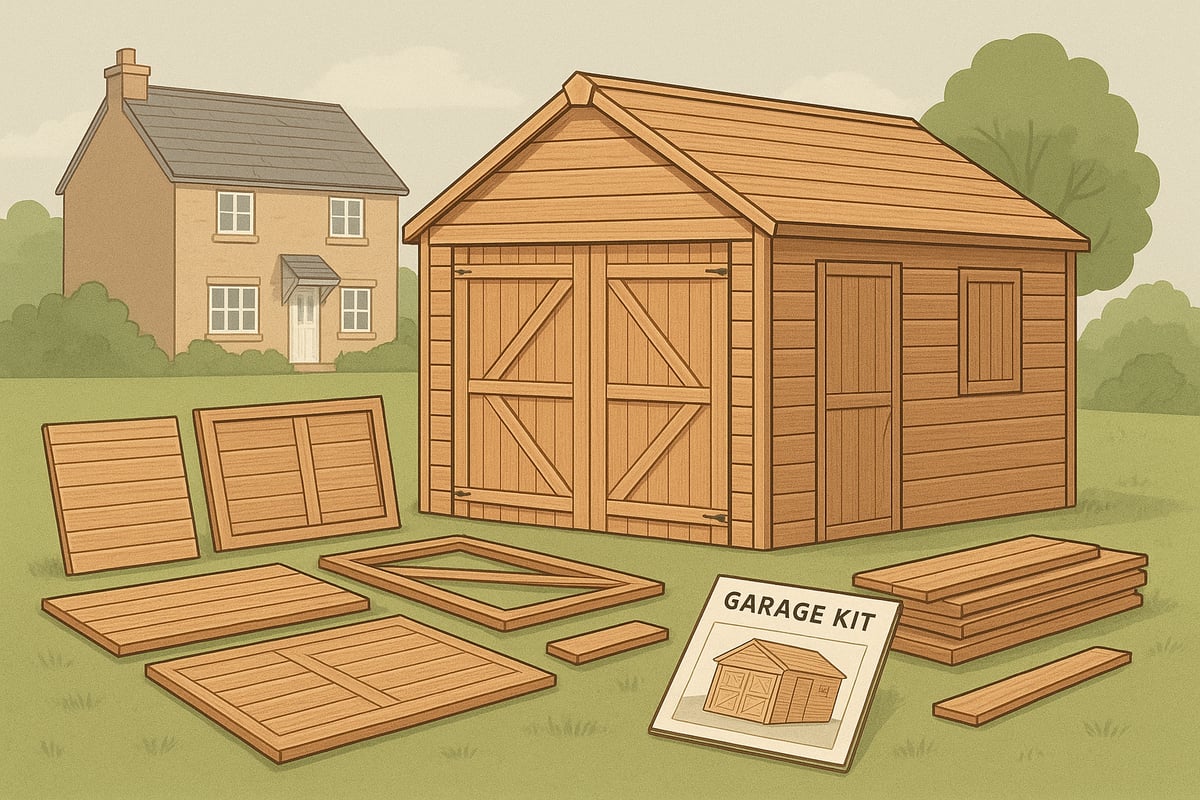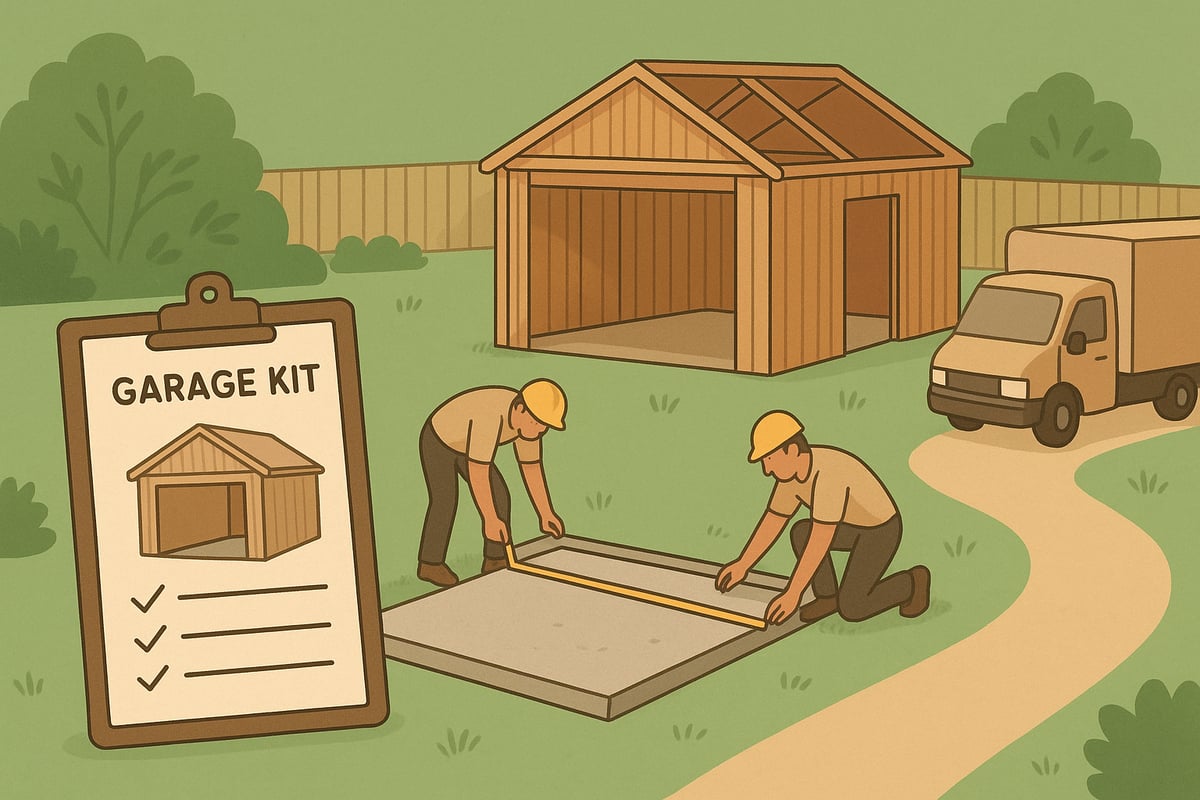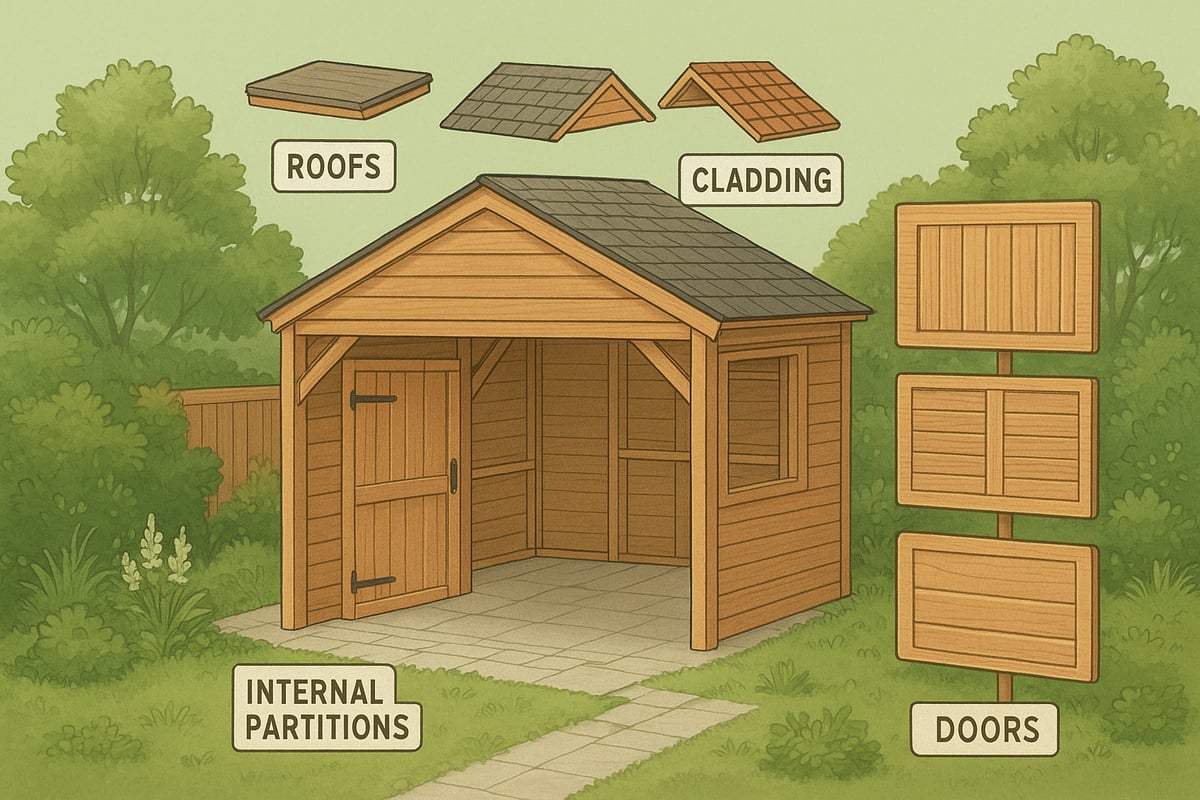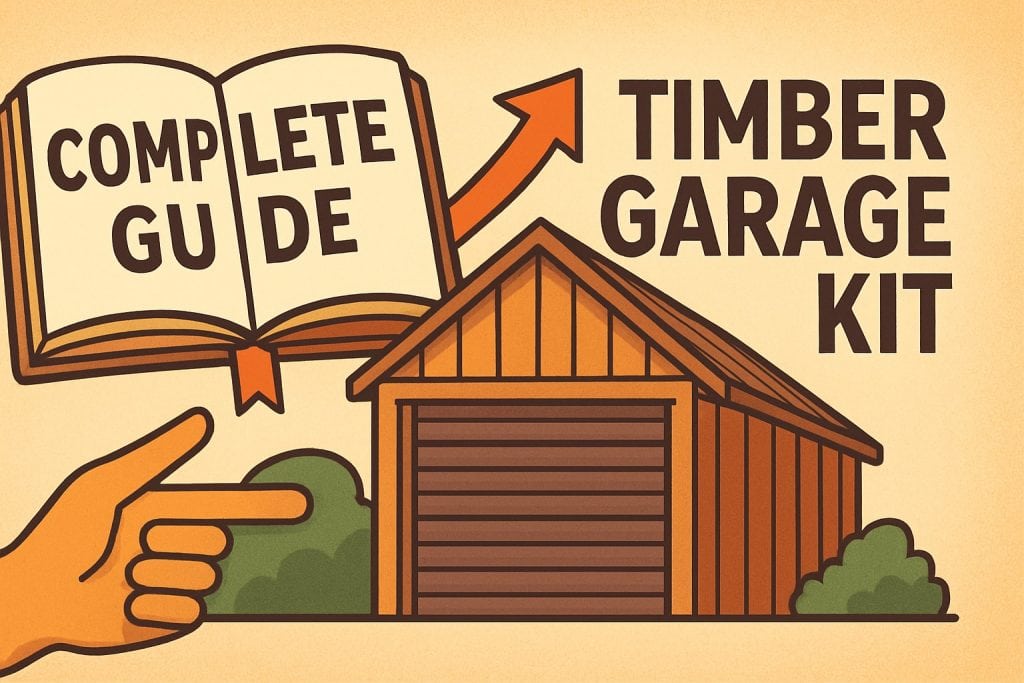Timber garage kits are quickly becoming the top choice for UK property owners in 2025, offering a cost-effective, sustainable, and stylish solution for modern living. With demand rising for flexible, DIY-friendly garages that boost both value and utility, more homeowners are exploring this innovative option.
Choosing a timber garage kit means you can enjoy customisation, long-lasting quality, environmental benefits, and straightforward installation. This guide will walk you through every step, from understanding what a timber garage kit is to planning, design, budgeting, installation, and ongoing maintenance, helping you make the right decision for your home.
Understanding Timber Garage Kits: What Are They and Why Choose One?
Timber garage kits are rapidly gaining traction in the UK, offering a blend of practicality, cost-effectiveness, and environmental responsibility. With more homeowners seeking flexible options for storage and workspace, the timber garage kit stands out as a modern yet timeless solution.

What is a Timber Garage Kit?
A timber garage kit is a prefabricated package containing all the necessary components to build a garage from timber. Unlike traditional brick-built garages, a timber garage kit is designed for straightforward assembly, often delivered as a flat-pack with pre-cut frames, wall panels, fixings, and clear instructions.
There are two main types: modular kits, which follow set designs and sizes, and bespoke kits tailored to individual requirements. Modular options are ideal for standard needs, while bespoke solutions allow for unique layouts or architectural features. For example, Passmores offers flat-pack kits with every component included and detailed assembly guidance, enabling confident DIY installation or a smooth handover to professionals.
Typical kit contents include:
| Component | Description |
|---|---|
| Frames | Pre-cut structural timber sections |
| Wall Panels | Cladding, insulation (optional) |
| Doors/Windows | Secure, customisable entry points |
| Fixtures | Screws, bolts, brackets |
| Instructions | Step-by-step assembly manual |
DIY assembly is popular for those with basic carpentry skills, saving on labour costs, while professional installation is available for added peace of mind. Prices are competitive, with single bay kits starting from £3,574. Importantly, timber is recognised as the only truly renewable construction material, making it a sustainable choice for eco-conscious buyers. For more on the environmental advantages, see the Sustainability of Timber as a Building Material.
Benefits of Timber Garage Kits
Choosing a timber garage kit offers numerous advantages over traditional builds. Cost savings are a major benefit, as both materials and construction are generally less expensive than brick or block alternatives. The flexibility in design is another strength, with options ranging from single to six-bay layouts and the ability to add features such as workshops, log stores, or office spaces.
Speed is a further advantage. A self-build timber garage kit can typically be erected within days rather than weeks, minimising disruption to your property. Sustainability is also a key factor, with many kits using FSC-certified or responsibly sourced timber. This not only reduces the carbon footprint but also appeals to those who value environmental stewardship.
Enhanced kerb appeal and property value are additional benefits. British-made kits from suppliers like Passmores and Roundwood boast quality craftsmanship and traditional design heritage. Customer reviews and supplier data suggest that, with proper care, timber garages can last over 50 years, rivaling more expensive masonry options.
Who Should Consider a Timber Garage Kit?
A timber garage kit is ideal for a wide range of property owners. Homeowners needing extra storage, a secure parking solution, or a dedicated workshop will find these kits practical and versatile. DIY enthusiasts are drawn to the satisfaction and potential savings of self-assembly projects, while property developers and architects appreciate the speed and cost-effectiveness for new builds or renovations.
Those prioritising sustainability and minimal environmental impact are especially well-suited to choosing a timber garage kit. The renewable nature of timber, combined with modern design and manufacturing standards, delivers a solution that aligns with both lifestyle needs and ethical values. Whether seeking a traditional look or a custom multi-use space, a timber garage kit offers adaptability and long-term value.
Key Factors to Consider When Choosing a Timber Garage Kit
Choosing the right timber garage kit involves careful consideration of several important factors. From size and layout to sustainability and supplier reputation, each element ensures your investment delivers maximum value, longevity, and aesthetic appeal. Let’s explore the key aspects to help you make an informed decision in 2025.

Size and Layout Options
The starting point for any timber garage kit is selecting the right size and layout to match your needs. Standard sizes typically range from 4.8m x 3.0m for a single bay up to 7.2m x 7.2m for larger configurations. Consider whether you need a single, double, or triple bay, and allow at least 1m of space around the structure for access and maintenance.
Some suppliers, such as Passmores, offer 1 to 6 bay garages, while others highlight bespoke layouts. For those interested in a compact solution, the One bay timber garage kit provides a clear example of a standard single-bay option, ideal for most homes or limited spaces.
Think about future needs as well. Will you require extra storage, a workshop, or a log store? Planning ahead ensures your timber garage kit remains functional for years to come.
Timber Quality and Sourcing
Quality timber is crucial for the strength and durability of your timber garage kit. Slow-grown timber, such as Scandinavian softwood or British oak, offers higher density and improved resistance to weather. Always check for FSC or PEFC certification, which confirms sustainable sourcing and responsible forestry practices.
Oak, softwood, and engineered timbers each have their advantages. Oak is exceptionally durable and striking, while softwood is cost-effective and easier to work with. For example, Passmores sources timber from managed Swedish forests, and Acorn to Oak Framing uses locally harvested oak for premium builds.
Choosing a kit with verified sourcing adds confidence that your investment is both robust and environmentally responsible.
Kit Features and Inclusions
Understanding what comes as standard with a timber garage kit helps you budget accurately and avoid surprises. Most kits include prefabricated frames, wall panels, fixings, doors, and detailed instructions. Optional extras may feature windows, pedestrian doors, office spaces, or insulation upgrades.
However, some essential elements, such as roofing materials (tiles or slates) and foundations, are often excluded. Suppliers like Passmores provide pre-finished panels and trial-assembled oak entrance frames, which simplify the build process.
Check the kit’s feature list carefully and clarify any exclusions before purchase, so you can account for all necessary materials and labour.
Customisation and Design Flexibility
One of the biggest advantages of a timber garage kit is the ability to tailor the design to your preferences. You can choose roof types (felt, tiles, slates), door styles (side-hung or up-and-over), and internal layouts to suit your needs. Modular kits offer standardised options for quick assembly, while bespoke kits allow for unique designs and features.
Suppliers like Roundwood and Acorn to Oak Framing provide both modular and fully bespoke solutions. Consider the pros and cons: modular kits are cost-effective and fast to install, while bespoke options offer maximum flexibility and individuality.
This level of customisation ensures your timber garage kit blends seamlessly with your property and lifestyle.
Durability and Longevity
A well-constructed timber garage kit is built to last. With proper treatment and maintenance, these structures can exceed 50 years of service. The lifespan depends on timber type, construction quality, and ongoing care.
Timber garages are naturally resistant to weather and pests when treated with quality preservatives. Softwood requires periodic re-treatment, while oak offers inherent durability. Regular maintenance, such as repainting and checking for leaks, is key to preserving your investment.
When comparing suppliers, look for customer reviews and testimonials that highlight long-lasting results.
Sustainability and Environmental Impact
Sustainability is a major reason many homeowners choose a timber garage kit. Timber is the only renewable mainstream construction material, with a much lower carbon footprint than brick or concrete. Many suppliers support responsible forestry, planting two trees for every one harvested.
FSC or PEFC certification ensures the wood is sourced from well-managed forests. For example, Passmores’ Swedish forestry scheme prioritises environmental responsibility, while Acorn to Oak Framing uses local, sustainably harvested oak.
By selecting a sustainable timber garage kit, you contribute to a greener future while enjoying a beautiful, functional structure.
Manufacturer Reputation and Support
The reputation of your chosen supplier is crucial for a successful project. Established manufacturers with a long history in the industry typically offer higher quality products, reliable customer support, and comprehensive after-sales service.
Look for suppliers who provide clear instructions, foundation drawings, and responsive assistance during and after installation. Customer testimonials and verified reviews offer valuable insight into product quality and service standards.
Passmores, with over 100 years of British craftsmanship, and Acorn to Oak Framing are examples of trusted names in the timber garage kit market. Choosing a reputable provider ensures peace of mind and a smooth building experience.
Planning, Permissions, and Site Preparation for Your Timber Garage Kit
Planning ahead is essential when investing in a timber garage kit. From securing the right permissions to preparing your site for installation, each step ensures your project runs smoothly and complies with UK regulations. This section walks you through the key considerations—from legal requirements to practical groundwork—so you can approach your timber garage kit build with confidence.

Understanding UK Planning Permission
Before ordering your timber garage kit, check if planning permission is required. In the UK, permitted development rights allow many homeowners to build garages without formal consent, provided certain criteria are met. Typical restrictions include proximity to property boundaries, total height, and whether the garage will be in front of the principal elevation.
If your property is listed or in a conservation area, or if the structure will be close to boundaries, you will likely need permission. Always confirm requirements with your local authority. For a comprehensive overview, consult the UK Planning Permission for Timber Garages guide, which details UK-specific conditions and permitted development rules.
Building Regulations and Compliance
Building regulations may apply to your timber garage kit depending on its size, use, and location. Regulations exist to ensure safety, energy efficiency, and structural soundness. For example, garages over 30m², or those intended for residential use, often require compliance checks.
Ensure your supplier provides detailed foundation and structural drawings tailored to your chosen timber garage kit. This documentation helps demonstrate compliance and is essential for both planning authorities and contractors. Always double-check measurements and standards before starting construction to avoid costly errors.
Preparing Your Site and Foundations
A solid, level foundation is vital for the longevity and stability of any timber garage kit. Begin by assessing your site for access, drainage, and space. Clear vegetation, remove debris, and level the area thoroughly.
Next, pour a concrete base to the recommended thickness, ensuring it matches the dimensions of your timber garage kit. Suppliers like Passmores often provide foundation drawings to guide this process. If in doubt, engage a local groundwork contractor with experience in timber outbuildings for best results.
Delivery and Access Considerations
Timely delivery and proper access are crucial for assembling your timber garage kit efficiently. Confirm that there is suitable access for a delivery lorry and adequate space to unload all components.
If you are not building immediately, store kit parts on bearers and cover them with a tarpaulin to protect against moisture. Check that the delivery area is free from obstructions, and arrange for extra hands if heavy items need to be moved. Being well-prepared will help prevent delays and damage to your timber garage kit.
Timeline and Project Planning
Effective project planning sets clear expectations for your timber garage kit build. Start by confirming lead times with your supplier, as manufacturing and delivery can take several weeks, especially during peak seasons.
Schedule site preparation, base construction, and delivery in advance to ensure a seamless workflow. Allow time for any required permissions or inspections. By mapping out these milestones, you will keep your timber garage kit project on track and avoid unnecessary setbacks.
Design, Customisation, and Additional Features
Choosing the right timber garage kit means more than just picking a size. Design options and custom features play a vital role in making your new garage both functional and attractive. Let us explore the essential elements to consider for a truly bespoke result.

Roof and Cladding Options
The roof is one of the most defining aspects of any timber garage kit. You can choose from felt, clay or concrete tiles, natural slates, or even green roofs for a contemporary aesthetic. Each roofing type offers its own balance of durability and visual appeal.
Cladding materials are equally important. Featheredge boarding provides a classic look, while shiplap and weatherboard add a modern touch. Oak cladding creates a premium finish and exceptional longevity. The right combination of roof and cladding enhances both kerb appeal and weather resistance for your timber garage kit.
Doors, Windows, and Access
When selecting a timber garage kit, consider how you will access and use the space. Side-hung doors offer a traditional appearance and easy manual operation. Up-and-over doors save space and provide quick access for vehicles.
Adding pedestrian doors and windows increases versatility. Natural light makes the interior more pleasant for working or storage. Security features, such as locking mechanisms and reinforced frames, can be added to your timber garage kit for peace of mind.
Internal Layouts and Multi-Use Spaces
A modern timber garage kit is more than just a place to park your car. Many homeowners use their garages as workshops, home offices, gyms, or hobby rooms. Partition walls can create separate zones for different activities or storage needs.
Consider your future requirements when planning the internal layout. A flexible design allows you to adapt the space as your lifestyle changes. With a well-designed timber garage kit, you can maximise both storage and usability.
Insulation and Year-Round Use
To make your timber garage kit comfortable all year round, insulation is key. Insulating the walls, roof, and floor helps maintain a stable temperature and reduces energy bills. Many kits allow for easy retrofitting of insulation after assembly.
If you plan to use the garage as an office or leisure space, consider double glazing for windows and draught-proofing doors. Proper insulation ensures your timber garage kit remains functional whatever the weather.
Finishing Touches and Accessories
Finishing details set your timber garage kit apart. Bargeboards, fascias, and gutters protect the structure and give a polished look. Other accessories include log stores, bike racks, shelving, and electric points.
Personal touches, such as painting or staining the timber, not only enhance appearance but also add an extra layer of protection. These finishing elements increase the lifespan and value of your timber garage kit.
Choosing Bespoke vs. Modular Kits
Deciding between a modular and a bespoke timber garage kit depends on your priorities. Modular kits offer faster delivery and lower costs, with a range of standard sizes and features. Bespoke solutions allow for complete personalisation, from unique layouts to premium materials.
If you require a truly tailored design, Bespoke timber garage solutions provide expert guidance and craftsmanship to create a structure that matches your exact requirements. Both options ensure your timber garage kit delivers quality, longevity, and utility.
Budgeting, Pricing, and Value for Money
Choosing a timber garage kit is a significant investment, so understanding the full cost and value is essential. From initial pricing to long-term benefits, careful budgeting will ensure you make the most informed decision for your property.
Cost Breakdown of Timber Garage Kits
Timber garage kit prices vary based on size, timber type, and features. For example, a single bay kit typically starts around £3,350 to £3,574. Double bay options range from £3,650 to £7,734, while a triple bay can exceed £4,650. Bespoke designs, premium timber, or additional features will increase the investment.
| Size | Approximate Price |
|---|---|
| Single bay | £3,350–£3,574 |
| Double bay | £3,650–£7,734 |
| Triple bay | £4,650+ |
The timber garage kit you choose should balance cost, quality, and your specific needs.
Hidden Costs and What’s Not Included
When budgeting for a timber garage kit, factor in possible exclusions. Most kits do not include:
- Roofing materials (tiles, felt, slates)
- Concrete base or groundworks
- Insulation and electrics
- Delivery and installation (sometimes extra)
Always check what is included in your timber garage kit quote. Delivery charges and installation fees can vary, so request a comprehensive breakdown before committing.
Saving Money with Self-Build Kits
Opting for a self-build timber garage kit can lead to substantial savings. By assembling the kit yourself, you may save up to 12 percent on labour costs. DIY installation is achievable for those with basic carpentry skills, but professional help is always an option if needed.
Consider the time and tools required for assembly. While self-build is cost-effective, ensure you are comfortable with the process before choosing this route for your timber garage kit.
Value Added to Property
A well-designed timber garage kit can add significant value to your property. Estate agents often highlight garages as desirable features that boost kerb appeal and marketability. Buyers appreciate the added storage, secure parking, and flexible use, making your home more attractive.
Investing in a high-quality timber garage kit is not just about immediate utility, but also long-term financial benefit.
Comparing Timber to Other Materials
When comparing a timber garage kit to brick or concrete structures, timber is generally more affordable and quicker to construct. The environmental impact is lower, as timber is renewable and stores carbon. Maintenance costs can be lower over time, especially with proper care, and timber garages are known to last 50 years or more.
Choosing timber offers a unique blend of sustainability, speed, and cost-effectiveness.
Financing and Payment Options
Many suppliers offer staged payments, deposits, or finance deals to help you spread the cost of your timber garage kit. Some provide online calculators for instant pricing, supporting transparent budgeting. For further guidance on pricing, inclusions, and common concerns, consult the Timber garage kit FAQs.
Planning your purchase thoroughly ensures you secure the best value for your investment.
Step-by-Step Guide to Ordering and Building Your Timber Garage Kit
Choosing and constructing a timber garage kit is a straightforward process when you break it down into manageable steps. By following this guide, you will ensure your new garage meets your needs, budget, and style preferences while complying with UK regulations.
Step 1: Assess Your Needs and Set a Budget
Start by considering what you require from your timber garage kit. Decide on the number of bays, intended use, and whether you need extra features like a workshop or storage space.
Set a realistic budget. Factor in not just the kit price, but also groundworks, delivery, and any extras. This step ensures you choose a timber garage kit that fits your lifestyle and financial plan.
Step 2: Research and Select a Supplier
Take time to compare reputable UK suppliers. Look for companies with a proven track record, genuine customer reviews, and comprehensive support.
Request brochures and sample designs. Ask questions about timber sourcing, kit inclusions, and after-sales assistance. Selecting a reliable supplier is essential for a smooth timber garage kit project.
Step 3: Finalise Design and Customisation
Decide between a standard or bespoke timber garage kit. Confirm details such as roof type, doors, windows, and internal layout.
Ensure your chosen supplier offers sustainable timber, like FSC-certified oak or softwood. Customisation at this stage will allow your timber garage kit to match your property and preferences.
Step 4: Obtain Planning Permission (if required)
Check if you need planning permission for your timber garage kit. Factors include proximity to boundaries, building size, and site location.
Consult your local authority early. For detailed guidance on compliance and safety, refer to Building Regulations for Timber Garages. Securing approval before starting prevents costly delays.
Step 5: Prepare the Site and Foundations
A solid, level concrete base is vital for your timber garage kit’s longevity and stability. Hire a professional groundworks contractor to clear, level, and measure the area.
Use foundation drawings provided by your supplier. Proper preparation ensures a hassle-free assembly and protects your investment.
Step 6: Place Your Order and Schedule Delivery
Once the design is final, confirm your order and arrange delivery. Double-check all details, including access for the delivery lorry and unloading requirements.
Schedule the groundwork and delivery dates so your timber garage kit components arrive when you are ready to build.
Step 7: Assemble the Garage Kit
Follow the instructions included with your timber garage kit carefully. Use standard carpentry tools and seek help from a builder or friend if needed.
Many kits, such as those from Passmores, can be assembled by two people in as little as two days. Take your time to ensure each part is fitted correctly.
Step 8: Add Finishing Touches and Optional Extras
Install doors, windows, fascias, and accessories to complete your timber garage kit. Consider painting, staining, or treating the timber for added protection and style.
Add any optional extras, such as shelving, electrics, or log stores, to make the space truly functional.
Step 9: Inspect and Maintain
After assembly, check the entire structure for quality, alignment, and completeness. Set up a maintenance schedule for regular cleaning and timber treatment.
For expert advice on keeping your timber garage kit in top condition, see this guide on Durability and Maintenance of Timber Garages. Proper care will ensure your investment lasts for generations.
By following these steps, you can confidently plan, order, and assemble a timber garage kit that enhances your property and meets your long-term needs.
Maintenance and Care for Your Timber Garage
Regular care is essential to keep your timber garage kit in top condition for decades. With the right approach, you can enjoy reliable performance, lasting beauty, and minimal disruptions. A well-maintained timber garage kit not only protects your investment but also ensures it continues to add value and utility to your property.
Routine Maintenance Tasks
Consistent upkeep is the backbone of preserving any timber garage kit. Begin with regular inspections to spot early signs of rot, insect activity, or weather damage. Check gutters and downpipes for blockages, as clear drainage prevents water pooling and timber decay.
- Inspect external surfaces for splits, warping, or loose fixings.
- Sweep leaves and debris from the roof and around the base.
- Clean cladding and trims to remove dirt and moss.
A proactive approach ensures your timber garage kit remains structurally sound and visually appealing.
Treating and Protecting Timber
Protective treatments are vital for extending the life of your timber garage kit. Use quality wood preservatives, stains, or paints specifically designed for outdoor timber. These products shield against moisture, UV rays, and fungal growth.
Apply treatments every two to five years, depending on exposure and product recommendations. Pay special attention to end grains, joints, and areas near the ground, as these are most vulnerable. If your kit uses oak or slow-grown softwood, follow supplier guidance for optimal protection.
Repairs and Upkeep
Addressing minor issues promptly prevents bigger problems. If you notice split boards, loose panels, or failing seals, repair or replace these components swiftly. For larger structures, such as three bay timber garage options, regular checks of all bays and doors are essential.
- Replace damaged weatherboards or trims.
- Re-seal joints and windows to maintain weatherproofing.
- Adjust doors and hinges for smooth operation.
If structural concerns arise, consult a professional for assessment and repair.
Seasonal Checks and Preparation
Seasonal changes can impact your timber garage kit. Before winter, check all seals and drainage to prevent water ingress and frost damage. Insulate vulnerable pipes or spaces if needed, and clear vegetation from the base to reduce damp.
In spring and summer, ventilate the interior to avoid condensation. Touch up any exposed areas with protective finishes and ensure pest defences are intact. These checks will help your timber garage kit withstand changing weather year-round.
Longevity Tips and Best Practices
To maximise the lifespan of your timber garage kit, follow these best practices:
- Maintain good airflow by keeping the base clear of soil and plants.
- Schedule annual inspections and cleanings.
- Re-treat timber at recommended intervals.
- Ensure gutters and downpipes are free-flowing.
With this approach, many timber garage kits have lasted over 50 years according to customer reviews.
Upgrading and Adapting Over Time
As your needs evolve, your timber garage kit can adapt too. Retrofitting insulation, adding electrics, or improving security are all possible upgrades. If your garage becomes a home office, gym, or workshop, consider installing additional windows or partitioning.
Regular care and thoughtful upgrades ensure your timber garage kit remains a valuable, versatile asset for years to come.
Now that you have a clear understanding of what to look for in a timber garage kit—from choosing the right size and layout to ensuring sustainable, high quality materials—why not take the next step towards transforming your property? At Acorn to Oak Framing, we combine traditional craftsmanship with modern design, so you get a bespoke garage that’s both beautiful and built to last. Whether you want a quick modular solution or a fully customised oak frame, we’re here to help you every step of the way. Let’s turn your vision into a reality—BUILD NOW.












